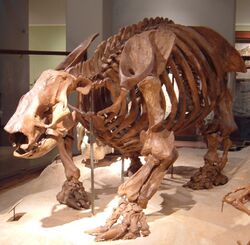Biology:Mylodontidae
| Mylodontidae | |
|---|---|

| |
| Paramylodon harlani at the Texas Memorial Museum, UT | |
| Scientific classification | |
| Domain: | Eukaryota |
| Kingdom: | Animalia |
| Phylum: | Chordata |
| Class: | Mammalia |
| Order: | Pilosa |
| Superfamily: | Mylodontoidea |
| Family: | †Mylodontidae Ameghino, 1889 |
| Subgroups | |
| |
Mylodontidae is a family of extinct South American and North American ground sloths within the suborder Folivora of order Pilosa, living from around 23 million years ago (Mya) to 11,000 years ago.[2] This family is most closely related to another family of extinct ground sloths, Scelidotheriidae, as well as to the extant arboreal two-toed sloths, family Choloepodidae; together these make up the superfamily Mylodontoidea. Phylogenetic analyses based on morphology uncovered the relationship between Mylodontidae and Scelidotheriidae; in fact, the latter was for a time considered a subfamily of mylodontids.[3] However, molecular sequence comparisons were needed for the correct placement of Choloepodidae. These studies have been carried out using mitochondrial DNA sequencesCite error: Closing </ref> missing for <ref> tag However, radiocarbon dates do not support simultaneous occupation of the site by humans and sloths.[4] Subfossil remains like coproliths, fur and skin have been discovered in some quantities. Mylodontids are the only ground sloths confirmed to have osteoderms embedded within their skin, though osteoderms were only present in a handful of genera (Mylodon, Paramylodon and Glossotherium) and absent in others.[5]
Phylogeny
The following sloth family phylogenetic tree is based on collagen and mitochondrial DNA sequence data (see Fig. 4 of Presslee et al., 2019).[6]
| Folivora |
| ||||||||||||||||||||||||||||||||||||||||||||||||||||||||||||||||||||||||||||||
References
- ↑ Rincón, Ascanio D.; Solórzano, Andrés; McDonald, H. Gregory; Flores, Mónica Núñez (7 April 2016). "Baraguatherium takumara, Gen. et Sp. Nov., the Earliest Mylodontoid Sloth (Early Miocene) from Northern South America". Journal of Mammalian Evolution 24 (2): 179–191. doi:10.1007/s10914-016-9328-y.
- ↑ http://paleodb.org/cgi-bin/bridge.pl?action=checkTaxonInfo&taxon_no=43629&is_real_user=1Mylodontidae: Paleobiology Database
- ↑ Gaudin, T. J. (1995-09-14). "The Ear Region of Edentates and the Phylogeny of the Tardigrada (Mammalia, Xenarthra)". Journal of Vertebrate Paleontology 15 (3): 672–705. doi:10.1080/02724634.1995.10011255. Bibcode: 1995JVPal..15..672G.
- ↑ Naish, Darren (28 Nov 2005). "Fossils explained 51: Sloths". Geology Today 21 (6): 232–238. doi:10.1111/j.1365-2451.2005.00538.x. https://www.researchgate.net/publication/264408400. Retrieved 2009-01-29.
- ↑ McDonald, H. Gregory (December 2018). "An Overview of the Presence of Osteoderms in Sloths: Implications for Osteoderms as a Plesiomorphic Character of the Xenarthra" (in en). Journal of Mammalian Evolution 25 (4): 485–493. doi:10.1007/s10914-017-9415-8. ISSN 1064-7554. http://link.springer.com/10.1007/s10914-017-9415-8.
- ↑ Cite error: Invalid
<ref>tag; no text was provided for refs namedPresslee2019
Bibliography
- Woodward, A.S. (1900): On some remains of Grypotherium (Neomylodon) listai and associated mammals from a cavern near Consuelo Cove, Last Hope Inlet. Proceedings of the Zoological Society of London, 1900(5): 64–79.
Further reading
- Brandoni, Diego; Scillato Yané, Gustavo J.; Miño Boilini, Ángel R.; Favotti, Emmanuel (2016). "Los Tardigrada (Mammalia, Xenarthra) de Argentina: diversidad, evolución y biogeografía". Contribuciones del MACN _: 263–274. http://naturalis.fcnym.unlp.edu.ar/repositorio/_documentos/sipcyt/bfa005048.pdf. Retrieved 2018-10-08.
- Cuvier, G. (1796): Notice sur le squelette d'une très grande espèce de quadrupède inconnue jusqu'à présent, trouvé au Paraguay, et déposé au cabinet d'histoire naturelle de Madrid. Magasin encyopédique, ou Journal des Sciences, des Lettres et des Arts (1): 303–310; (2): 227–228.
- De Iuliis, G. & Cartelle, C. (1999): A new giant megatheriine ground sloth (Mammalia: Xenarthra: Megatheriidae) from the late Blancan to early Irvingtonian of Florida. Zool. J. Linn. Soc. 127(4): 495–515.
- Harrington, C.R. (1993): Yukon Beringia Interpretive Center - Jefferson's Ground Sloth. Retrieved 2008-JAN-24.
- Hogan, C.M. (2008): Cueva del Milodon, Megalithic Portal. Retrieved 2008-APR-13
- Kurtén, Björn and Anderson, Elaine (1980): Pleistocene Mammals of North America. Columbia University Press, New York. ISBN:0-231-03733-3
- McKenna, Malcolm C. & Bell, Susan K. (1997): Classification of Mammals Above the Species Level. Columbia University Press, New York. ISBN:0-231-11013-8
- Nowak, R.M. (1999): Walker's Mammals of the World (Vol. 2). Johns Hopkins University Press, London.
- White, J.L. (1993): Indicators of locomotor habits in Xenarthrans: Evidence for locomotor heterogeneity among fossil sloths. Journal of Vertebrate Paleontology, 13(2): 230–242.
- White, J.L.; MacPhee, R.D.E. (2001). "The sloths of the West Indies: a systematic and phylogenetic review". in Woods, C.A.; Sergile, F.E.. Biogeography of the West Indies: Patterns and Perspectives. Boca Raton, London, New York, and Washington, D.C.: CRC Press. pp. 201–235. doi:10.1201/9781420039481-14. ISBN 978-0-8493-2001-9. https://books.google.com/books?id=f33LBQAAQBAJ&pg=PA201.
External links
| Wikimedia Commons has media related to Ground Sloth. |
- Sloth World: An Online Sloth Bibliography
- Picture and information about a ground sloth skeleton on display at the University of Georgia's Science Library
- Academy of Natural Sciences ground sloth page
- Illinois State Museum ground sloth page
- Ground sloths at La Brea
- Eremotherium in Florida
- Have some ground sloths survived in Argentina?
- Ground sloths in general
- Western Center for Archaeology and Paleontology Hemet, CA
Wikidata ☰ Q1749282 entry
 |


